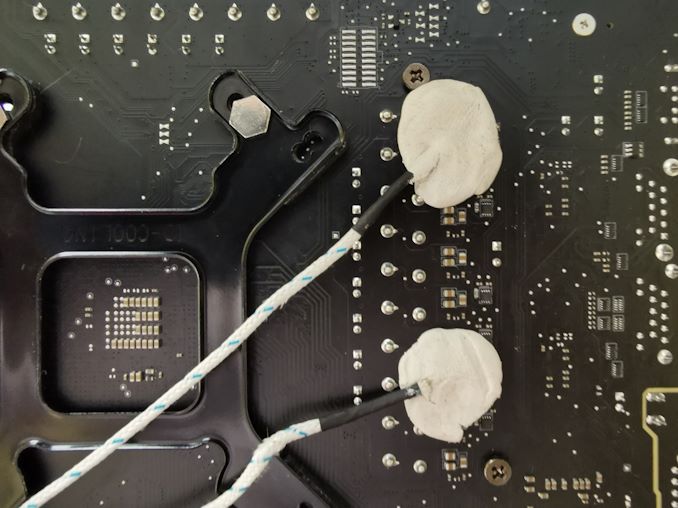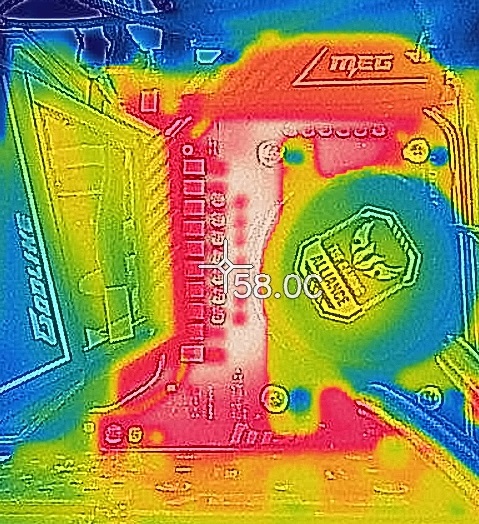The MSI MEG X570 Godlike Motherboard Review: Thor's Flagship
by Gavin Bonshor on August 28, 2019 12:00 PM EST- Posted in
- Motherboards
- AMD
- MSI
- 10G Ethernet
- Ryzen
- PCIe 4.0
- Ryzen 3000
- X570
- X570 Godlike
- MEG
Power Delivery Thermal Analysis
One of the most requested elements of our motherboard reviews revolves around the power delivery and its componentry. Aside from the quality of the components and its capability for overclocking to push out higher clock speeds which in turn improves performance, is the thermal capability of the cooling solutions implemented by manufacturers. While almost always fine for users running processors at default settings, the cooling capability of the VRMs isn't something that users should worry too much about, but for those looking to squeeze out extra performance from the CPU via overclocking, this puts extra pressure on the power delivery and in turn, generates extra heat. This is why more premium models often include heatsinks on its models with better cooling designs, heftier chunks of metal, and in some cases, even with water blocks such as the ASUS ROG Crosshair VIII Formula.

Two K-Type Thermal Probes attached to the rear of the power delivery on the MSI MEG X570 Godlike
Testing Methodology
Out method of testing out if the power delivery and its heatsink are effective at dissipating heat, is by running an intensely heavy CPU workload for a prolonged method of time. We apply an overclock which is deemed safe and at the maximum that the silicon on our AMD Ryzen 7 3700X processor allows. We then run the Prime95 with AVX2 enabled under a torture test for an hour at the maximum stable overclock we can which puts insane pressure on the processor. We collect our data via three different methods which include the following:
- Taking a thermal image from a birds-eye view after an hour with a Flir Pro thermal imaging camera
- Securing two probes on to the rear of the PCB, right underneath CPU VCore section of the power delivery for better parity in case a probe reports a faulty reading
- Taking a reading of the VRM temperature from the sensor reading within the HWInfo monitoring application
The reason for using three different methods is that some sensors can read inaccurate temperatures, which can give very erratic results for users looking to gauge whether an overclock is too much pressure for the power delivery handle. With using a probe on the rear, it can also show the efficiency of the power stages and heatsinks as a wide margin between the probe and sensor temperature can show that the heatsink is dissipating heat and that the design is working, or that the internal sensor is massively wrong. To ensure our probe was accurate prior to testing, I personally binned 10 and selected the most accurate (within 1c of the actual temperature) for better parity in our testing.
For thermal image, we use a Flir One camera as it gives a good indication of where the heat is generated around the socket area, as some designs use different configurations and an evenly spread power delivery with good components will usually generate less heat. Manufacturers who use inefficient heatsinks and cheap out on power delivery components should run hotter than those who have invested. Of course, a $700 flagship motherboard is likely to outperform a cheaper $100 model under the same testing conditions, but it is still worth testing to see which vendors are doing things correctly.
Thermal Analysis Results

We measured 58°C on PCB between the CPU socket and power delivery
The MSI MEG X570 Godlike is running a 14-phase design for the CPU VCore section. This includes an International Rectifier IR35201 running in a 7+1 configuration with seven IR3599 doublers on the rear of the PCB; the SoC section is running four phases off a single IR3599 which splits the signal into four. As far as designs go, this is MSI's best AMD power delivery that I can recall seeing, although I still find it a little odd that the SoC section is split into four, but through one IR3599 doubler in quad mode. Perhaps this will yield some benefits and gains for extreme overclockers, but it's not an issue for general users to be concerned about. The heatsink is very similar to the MSI MEG X570 Ace and uses the same design. The power delivery heatsinks are interconnected by a heat pipe which stretches around the left side of the memory slots and down into the actively cooled X570 chipset heatsink.
As we get more results, we will endeavour to update this chart when more models have been tested
Note - The ASRock B450 Gaming ITX-ac model crashed instantly every time the small FFT torture test within Prime95 was initiated. At anything on the CPU VCore above 1.35 V would result in instant instability. The Ryzen Master auto-overclocking function failed every time it tried to dial in settings, but it does however operate absolutely fine at stock, and with Precision Boost Overdrive enabled. Either the firmware is the issue, or the board just isn't capable of overclocking the Ryzen 3700X with extreme workloads with what is considered a stable overclock on the X570 chipset. We will re-test this in the future.
The power delivery on the MSI MEG X570 Godlike actually runs slightly cooler in our testing which can be explained by having a slightly better 14+4 power delivery versus the 12+2 design on the MSI MEG X570 Ace. More phases usually generate less heat overall as each phase is active for a shorter period of time, which does show in our testing. We ran our AMD Ryzen 7 3700X testbed sample at 4.1 GHz with a CPU VCore of 1.45 V which is consistent with other models we have tested to try and generate as much heat as possible. The power delivery probe output reading was 59°C after an hour of testing, while the VRM temperature sensor gave us a reading of 61°C. The MSI MEG X570 Godlike does well under our testing method and there should be no issues when overclocking the current Ryzen 3000 processors, as we found that we hit CPU thermal limitations before anything else.











116 Comments
View All Comments
imaheadcase - Wednesday, August 28, 2019 - link
I mean it is cool and nice features, but $700 for a mobo when its the core component of a system..and also the one that is easiest to get outdated faster is kinda silly. I suppose the argument is that if buying it not really going to care about costs anyways. hehegoatfajitas - Wednesday, August 28, 2019 - link
Yeah, especially when there are alot of motherboards that are very nearly as good for a lot less. These $700 models probably overclock like crazy, but it's just not as needed as it was 10+ years ago. CPU is almost never the bottleneck anymore so overclocking it is kinda moot.Smell This - Wednesday, August 28, 2019 - link
Odd in that MSI CEO Charles Chiang dumped-on AMD 8 months ago --- then proceeds to market $700+ SP3 motherboards ...
https://www.tomshardware.com/news/msi-ceo-intervie...
Samus - Wednesday, August 28, 2019 - link
I remember that article and was actually thinking the same thing. What honor is there in stabbing someone in the back then patting them on the back 8 months later?Peter2k - Thursday, August 29, 2019 - link
Because Gigabyte and Asus have 700$ boards with they're gaming brands?WaltC - Thursday, August 29, 2019 - link
Yes, and funny thing is....look what they're doing to retrofit their cheap x370/x470 motherboards to Zen 2...;) Sort of puts him in the "I don't know what I'm saying sometimes" category, eh? Too funny!ballsystemlord - Thursday, August 29, 2019 - link
I just read the article and can't find a single stab. He said only that AMD did not have good support a few years ago. Such a statement is either fact or fiction, and if fact, then totally benign.Point out to me the correct position in the article if I'm wrong.
Smell This - Tuesday, September 3, 2019 - link
MSI and **Chuckles** abandoned AMD -- not the other way around. Fair-Weather Chuck took his payola from Chipzillah and scooted, leaving AM2/AM3/AM4 in the wind (until he saw the $$$).It's been downhill for MSI since the 790FX K9A2 Platinum ...
Sweetbabyjays - Wednesday, August 28, 2019 - link
"overclock like crazy" I know right! Going from 4.0 to 4.2 GHz is pretty crazy. Totally worth the extra $450 you're paying.Seriously for this price you're better off getting a 9900k and a high end z390 board if you're fine with 8c/16t. Overclock to 4.8GHz on all cores and call it a day for same price as just the x570 motherboard. A 9900k at 4.8GHz is better than any 8c/16t AMD CPU in literally every single scenario.
Tunnah - Wednesday, August 28, 2019 - link
So you'd settle for a more power hungry CPU, with a motherboard with less future proofing, less expansion, and less features, just for the few percent difference in performance ?